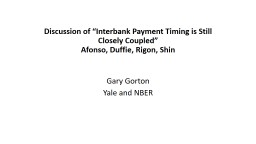

Afonso Duffie Rigon Shin Gary Gorton Yale and NBER Important Topic Evidence suggests that strategic cash hoarding reduces liquidity These dynamics are especially important if adjustments in the timing of payments occur on days when reserve balances in the banking system are relatively ID: 1003327
Download Presentation The PPT/PDF document "Discussion of “ Interbank Payment Timi..." is the property of its rightful owner. Permission is granted to download and print the materials on this web site for personal, non-commercial use only, and to display it on your personal computer provided you do not modify the materials and that you retain all copyright notices contained in the materials. By downloading content from our website, you accept the terms of this agreement.
1. Discussion of “Interbank Payment Timing is Still Closely Coupled”Afonso, Duffie, Rigon, ShinGary GortonYale and NBER
2. Important TopicEvidence suggests that strategic cash hoarding reduces liquidity.“These dynamics are especially important if adjustments in the timing of payments occur on days when reserve balances in the banking system are relatively low, because banks might also need to further adjust their liquidity management practices, reinforcing the strategic complementarity of payment timing.”Banks appear to be very risk averse with respect to holding cash.
3. Main Point of the PaperBanks continue to use incoming payments to make outgoing payments, despite large amounts of reserves.Surprising.“Strategic complementarity” - - repeated 22 times in the paper and an additional twice in the abstract.
4. MacAndrews and Rajan (2000) found the same result.“We find that incoming payments used by banks to offset outgoing payments that are entered within the same minute account for 25 percent of the value of these transfers during normal activity periods and as much as 40 percent during peak periods.”
5.
6. ExplanationAuthors suggest that the explanation for their findings is that banks are more risk averse - - hoarding reserves.But then there should other evidence that banks have become more risk averse about hoarding cash.For example, have they cut back on credit lines?
7. How Can Banks Pay?Bank A needs to pay Bank B $100. Bank A’s choices:Pay out of reservesUse payments received, if availableDaylight overdraftBorrow from other banks4 is too expensive.
8.
9.
10. Using Reserves More Frequently Afterall?If daylight overdrafts are not used, and incoming used to pay to roughly the same extent now as before, then reserves are being used more.Best to do what MacAndrews and Rajan did: account for all sources of funds.
11. Strategic Complementarity?Best evidence: “the relationship varies for different level of opening balances: On days with high aggregate opening balances, the link between payments and past receipts persists, but is dampened relative to days with low aggregate balances.”
12. But - - To what extent is the matching of outflows to incoming payments a matter of many, many payments in each direction?With thousands of payments, it seems likely that many would match the criterion of outflow matched by inflow in the last 15 minutes.Placebo tests: How about inflow matched by outflow in the last 15 minutes.
13. Thank You